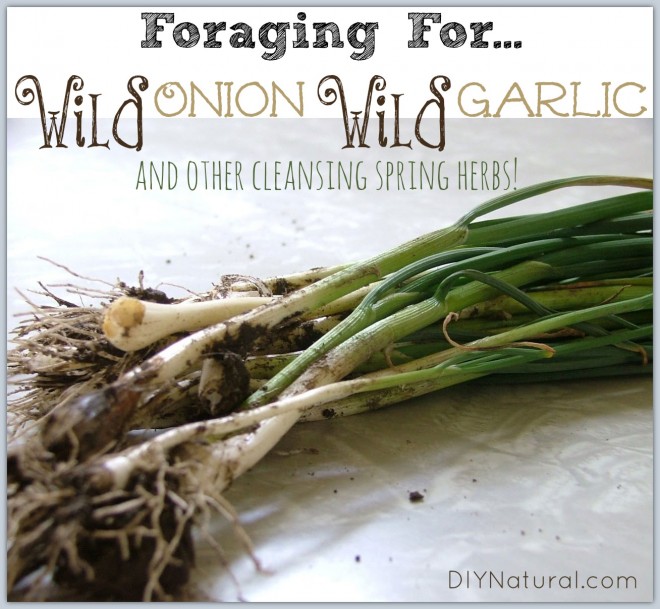
The end of winter is nearing in my part of the country and I couldn’t be happier. Today I went for a hike with some friends and had a great time. Despite the snowstorm we had recently, there are things popping up all over the woods. We spotted some very useful early spring herbs that are perfect for spring cleansing! Keep reading to see what I found and how I plan to use it.
Cleansing Early-Spring Herbs
Chickweed
Right now, chickweed is out and thriving. I know most people with lawns hate it, but the truth is that if you leave it it’ll die back when the hot weather comes. And before it does, grab some for your salad. It’s high in vitamins A, B and C and loaded with antioxidants. It also contains saponins which are thought to help break down fat in the body. Herbalist Susun Weed recommends it highly. (Read more about it here.) Eat it raw, in salads or steam it like spinach.
Wild onions & garlic
Wild onions and garlic are out in my area now too. Although they are tiny, they pack a lot of flavor. Use as you would larger onions or garlic, or just use the tops like chives. Onions and garlic pack a lot of nutrients for your body, among them sulfides, which can help treat some viruses. They can also help to lower high blood pressure and cholesterol levels. (Read more about it here.)
Garlic mustard
Garlic mustard is just starting to green up now in this area. It has been used for respiratory problems in the past and can be used for bronchitis and some bacterial infections. (See more here.) The easiest way to use it is to crush the leaves and lay them on your chest. Cover with a warm towel and let sit for half an hour or so. This isn’t a true “mustard” plaster, but more of a garlic wrap. You can also make a tincture or a tea, but the taste might not be pleasant.
Wild violets
The leaves of the wild violets are easy to find now, and the showy purple, white or yellow flowers will follow soon. Violets contain methyl salicylates, the forerunner of aspirin. You can make a tea out of the leaves and flowers for a mild pain killing effect. They can also be used for gastrointestinal problems and respiratory problems. They have been considered a food source in the past as all parts of the plant can be eaten.
Mosses & lichens
Many forms of mosses and lichens can be found now as well. One of my favorites is oakmoss. As mentioned in this soap making article, it’s a natural exfoliant. It acts like loofah in soap. I love the smell and feel of it. It has also been used in potpourri to hold the scent of whatever you use. To use it, collect some from the woods and dry thoroughly. When it’s completely dry (I use a dehydrator for mine), chop it up with a food processor or coffee grinder. Then add it to cold process or glycerin soap when you’re making it.
Another lichen I like is usnea. It’s found in the woods along with oakmoss. Usnea has a high amount of usneic acid and Vitamin C. Usneic acid is a powerful antibiotic and antifungal. Make a tea from it when you feel a cold coming on. It’s not the best for flavor, so you might want to add honey or another natural sweetener to perk it up. (Read more about usnea here.)
Horsetail
I saw some horsetail on the hill by the river today too. I’d forgotten about this plant until I saw it again. Horsetail is high in silica – in fact, it has the highest known silica content known in any plant. Make a tea from it to strengthen bones and nails. Cool the same tea and use for dandruff. It may also help with kidney stones and arthritis. (Read more about it here.)
Plantain
And last but not least, my favorite herb of the woods grows more on the edge of it. Plantain comes in two main types, the broad leaf and the narrow or lance leaf. Both are found in most areas and both have tremendous value as a healing agent. I dry as much plantain as I can to use later in my soaps and lotions. I make a tea from it to use in place of water in my soap recipe and then crumble some dried leaves into the soap itself. The plant is edible and can be used many ways. You can drink the tea, chop it up and put it on bug bites and scratches, make an infused oil with it (see how here) or eat it raw in salads to get the nutrients from it. However you use it, plantain is a very helpful plant. (You can read more on plantain here).
Have you taken a walk in the late winter woods? Did you make any surprising discoveries?
*******




I have a few things poping up in my yard but haven’t been in the woods yet because it won’t ever quit raining or snowing
down here in Lexington NC. Debra, do ever see any Birch trees up there. I have read that they grow at the higher elavations. I plan to come look for some on the Parkway this summer to see if I can find a Chaga conk on one.
Here in WV, this time of year–ramps start coming in and are closely related to wild onions and garlic. But, do they ever reek!!